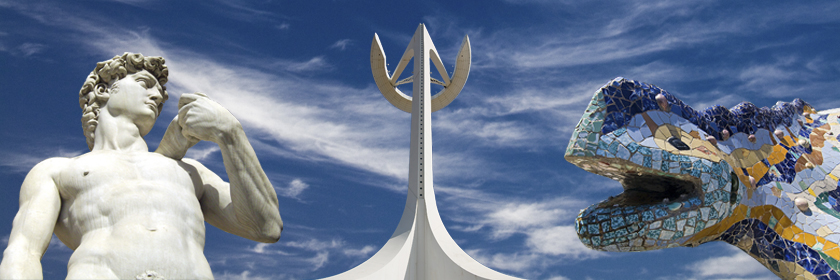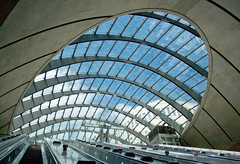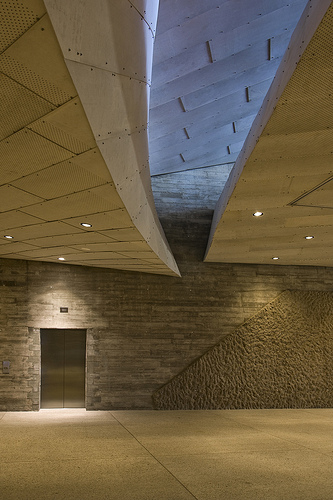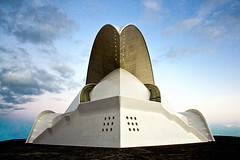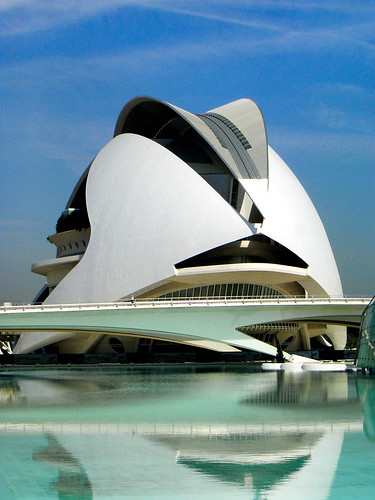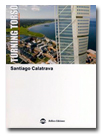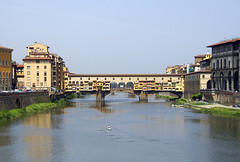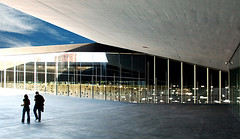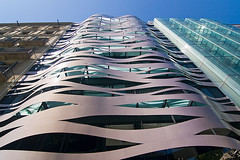ARCHITECTS / B. MIKAELIAN
Harilaos Trikoupis Bridge
Athens, Greece
HOME GEOGRAPHY ARCHITECTURE ENGINEERING SKYSCRAPERS
BRIDGES BUILDINGS TOWERS PUBLICATIONS ABOUT ME CONTACT
Copyright © José Miguel Hernández Hernández
Editor, Escritor y Fotógrafo de Arquitectura /
Publisher, Writer and Architectural Photographer
http://www.jmhdezhdez.com/ Leer más...
Etiquetas:
Antirion,
B. Mikaelian,
GRECIA,
Greece,
Harilaos Trikoupis Bridge,
rio
Harilaos Trikoupis Bridge, Athens, Greece, 1999-2004

ESPAÑOL
Promotor: Autoridades Locales de Atenas, Grecia
Arquitecto: B. Mikaelian, Paris, Francia
Ingeniero Estructural:
VINCI, Paris, Francia
INGEROP, Paris, Francia
DOMI, Atenas, Grecia
Buckland and Taylor, Vancouver, Canada
DENCO, Atenas, Grecia
Tipo: Puente atirantado
Longitud: 2252 metros
Ancho: 27.20 metros
Conocido también como "The Rion – Antirion Bridge", ya que une las dos ciudades con la misma designación, el Puente Harilaos Trikoupis lleva este nombre en honor al Primer Ministro quien dirigió a Grecia durante nada menos que cuatro décadas. El puente hace la función de conectar la zona norte del Peloponeso con el resto del país. Harilaos Trikoupis (1832-1896), en mi opinión fue el verdadero artífice y quien tuvo la visión desde un principio para la construcción de este necesario puente para unir las dos regiones de Grecia, aunque, no obstante, durante su mandato no contó con los medios adecuados para poder llevarlo a cabo. Casi un siglo después de su muerte y madurando la idea por parte de las Autoridades Locales de Grecia, a finales de la década de los años 1990 se realizaba el encargo a un importante equipo de arquitectos e ingenieros de diferentes partes del mundo para el diseño de un nuevo puente que salvase la enorme distancia de más de dos kilómetros de longitud, uniendo así ambas penínsulas. Con la construcción del nuevo puente se iba a ganar mucho tiempo y dinero por parte de los miles de usuarios que lo atravesarían diariamente, ya que hasta ese momento sólo habían podido cruzar el estrecho mediante Ferry. El equipo de arquitectos e ingenieros idearon un puente atirantado realmente innovador mediante cuatro enormes pilones de hormigón armado y que a modo de árboles, se situaron en el centro de los dos acercamientos a ambas orillas, uno a 392 metros de distancia, y el otro a 239 metros de distancia, respectivamente.

El enorme reto de este interesante proyecto consistía también en que el nuevo puente se iba a asentar sobre un terreno algo débil bajo las aguas del mar a nada menos que 65 metros de profundidad y con una actividad sísmica considerable; este último dato motivó que ambos extremos del puente se asentaran sobre una cimentación mediante placas tectónicas para contrarrestar los posibles movimientos en caso de un posible terremoto. El proceso constructivo del puente no fue nada sencillo. Después de construir los cuatro islotes circulares de 90 metros de diámetro cada uno, se erigieron los enormes pilones de hormigón armado y a continuación se fueron construyendo las diferentes secciones que componen el tablero. Los tirantes hacen que el tablero vaya creciendo hacia ambos lados de cada pilón uniendo así los diferentes tramos de la cubierta. La estructura superior de hormigón armado de cada pilón está formada por cuatro pilares inclinados con sección rectangular y que formando una pirámide, hacen también la labor de recibir a los tirantes de acero. Esta estructura superior se ancla a otra enorme base de hormigón armado que tiene la forma de una sección de pirámide invertida y base cuadrangular; estas bases inferiores se sitúan a diferentes alturas con respecto al nivel del mar.

El conjunto de cada pilón, que trabaja a compresión, soporta todo el peso del tablero mediante 8 juegos de 23 pares de cables atirantados. Estos tirantes de acero se anclan a diferentes perfiles metálicos que se conectan a su vez con la estructura metálica longitudinal que forma parte del tablero. Los cables atirantados, que trabajan a tracción y que arrancan desde la estructura superior de hormigón armado de forma piramidal, contienen en su interior cables más pequeños de acero galvanizado, entre 43 y 73, y quedan unidos por el recubrimiento de una funda cilíndrica tipo HDPE. El ancho del puente, de 27.20 metros, ofrece un servicio de dos carriles para cada sentido de tráfico rodado y otras dos pasarelas para peatones y bicicletas en los extremos. La estructura del tablero está compuesta por unas enormes vigas longitudinales de acero de 2.20 metros de altura, que quedan unidas por otras vigas metálicas transversales situadas cada cuatro metros. Después de hormigonar la solera se realizó sobre esta un asfaltado de entre 25 cm. y 35 cm. de espesor. El puente se diseñó también expresamente para dejar paso a los barcos de gran envergadura bajo su paso inferior. El Harilaos Trikoupis Bridge, por su diseño e innovación, y como todo un reto debido a las dificultades añadidas con las que contó desde un principio, se ha convertido, sin lugar a dudas, en uno de los puentes atirantados más largos e importantes de Europa y también del mundo.
Datos de interés:
Hormigón (m3): 210 000
Acero de refuerzo (t): 57 000
Acero estructural (t): 28 000
Peso de los cables (t): 3800
Costo total (EUR millones): 750
Fecha de servicio: 2004 de agosto

ENGLISH
Promoter: Local Authorities in Athens, Greece
Architect: B. Mikaelian, Paris, France
Structural Engineer:
VINCI, Paris, France
INGEROP, Paris, France
DOMI, Athens, Greece
Buckland and Taylor, Vancouver, Canada
DENCO, Athens, Greece
Type: Cable-stayed bridge
Length: 2252 meters
Width: 27.20 meterS
Also known as "The Rion - Antirion Bridge", and linking the two cities with the same designation, Harilaos Trikoupis Bridge is named in honor of the Prime Minister who went to Greece for no less than four decades. The bridge serves as a connecting the north of the Peloponnese with the rest of the country. Harilaos Trikoupis (1832-1896), in my opinion was the true architect and who had the vision from the beginning to build this necessary bridge linking the two regions of Greece, although, however, during his tenure did not have the appropriate means to carry it out. Almost a century after his death and are thinking on the part of Local Authorities of Greece, to the late 1990s the commission was made a senior team of architects and engineers from around the world to design a new bridge to bridge the enormous distance of more than two miles long, thus linking the two peninsulas. With the construction of the new bridge was going to make a lot of time and money by thousands of users who pass through daily, and that until then had only been able to cross the strait by ferry. The team of architects and engineers devised a truly innovative cable-stayed bridge with four huge concrete pylons and trees that way, were at the center of the two approaches on both sides, one to 392 feet away, and the other 239 meters away, respectively.

The enormous challenge of this project was also interesting that the new bridge was going to settle on a rather weak field under the sea no less than 65 meters depth and a considerable seismic activity, the latter data prompted both ends Bridge to settle on a foundation by tectonic plates to counteract any movements in the event of a possible earthquake. The construction process of the bridge was not simple. After building the four circular islands 90 meters in diameter each, were erected huge concrete pylons were built and then the different sections that make up the board. The straps make the board grows towards both sides of each loaf uniting the different sections of the roof. The concrete superstructure of each pylon is composed of four pillars inclined rectangular section and forming a pyramid, they also welcome the work of steel braces. This upper structure is anchored to another huge concrete base which is shaped like an inverted pyramid section and square base, these bases are located below at different heights with respect to sea level.

The combination of each pylon, which is under compression, supports the entire weight of the board with 8 sets of 23 pairs of stay cables. These steel straps are anchored to different hardware profiles that in turn are connected with longitudinal metal structure that is part of the board. The stay cables, which work to drive and started from the upper structure of pyramid-shaped concrete, contain within them smaller cables galvanized steel, between 43 and 73, and are joined by a cylindrical sleeve coated HDPE type . The width of the bridge of 27.20 meters, offers a two lanes for each direction of traffic and two pedestrian walkways and bicycle at the ends. The structure of the board consists of enormous steel stringers of 2.20 meters, which are joined by other cross girders placed every four feet. After concreting the slab was carried out on this one asphalting of 25 cm. and 35 cm. thick. The bridge was also designed specifically to make way for large vessels under his bottom. Harilaos Trikoupis The Bridge, by design and innovation, and as a challenge due to the additional difficulties with which they had from the start has, undoubtedly, one of the longest cable-stayed bridges and major European and the world.
Useful information:
Concrete (m3): 210 000
Reinforcing steel (t): 57 000
Structural Steel (tonnes): 28,000
Weight of cables (t): 3800
Total cost (EUR million): 750
Service Date: August 2004

"Images Harilaos Trikoupis Bridge, Athens, Greece"
Image 1 Copyright © GEFYRA, Website
Image 2 Copyright © GEFYRA - Nikos Daniilidis, License
Image 3 Copyright © Ranong Payakapan, Flickr
Image 4-5 Copyright © Ava Babili, Flickr
Image 6-7 Copyright © Styliadis Kostas, Flickr
"Text" Copyright © José Miguel Hernández Hernández
Editor, Escritor y Fotógrafo de Arquitectura /
Publisher, Writer and Architectural Photographer
Todos los derechos reservados / All rights reserved
www.jmhdezhdez.com
Related articles / Artículos relacionados
Megyeri Bridge
Budapest, Hungary
Mátyás Hunyadi
Viaduct Millau
Aveyron, France
Foster + Partners and
Michel Virlogeux
MUY IMPORTANTE!!! VERY IMPORTANT!!!
Deja tu comentario sobre este reportaje al pie de este post donde dice "Publicar un comentario en la entrada"; me será de gran valor para seguir mejorando este sitio web y te contestaré con la mayor brevedad posible... Muchas gracias!
No obstante, si te ha resultado interesante este reportaje y también el Blog en general, por favor, no dudes en hacerte Fan de la página de Fans del Blog de José Miguel Hernández Hernández en Facebook aquí
Nota importante: Una vez que hayas entrado en la página de Fans del Blog en Facebook, con sólo hacer click en el botón de "Me gusta", a partir de ese momento estarás al tanto de todos los nuevos reportajes interesantes relacionados con la Arquitectura y la Ingeniería que aquí se vayan publicando para no perder ningún detalle...
También puedes suscribirte por e-mail (te llegaría un e-mail con el enlace de cada artículo en el mismo momento en que sea publicado), o bien también puedes seguir el Blog a través de Twitter aquí
Nos vemos en el Blog!
Leave a comment on this story at the bottom of this post where it says "Post a comment in the entry", I will prove invaluable to further improve this website and I will answer as soon as possible .. . Thank you very much!
However, if you this story was interesting and the blog in general, please do not hesitate to make Fan Fans of the Blog page José Miguel Hernández Hernández on Facebook here
Very important: Once you enter the page Blog fan of Facebook, simply click on the button Like "From that moment you are aware of all new interesting stories related to the Architecture and Engineering are published here to avoid losing any detail ...
Can also subscribe by e-mail (I would e-mail with a link to each item in the same time it is published), or you can follow through Blog Twitter here
See you at the Blog!
HOME GEOGRAPHY ARCHITECTURE ENGINEERING SKYSCRAPERS
BRIDGES BUILDINGS TOWERS PUBLICATIONS ABOUT ME CONTACT
Copyright © José Miguel Hernández Hernández
Editor, Escritor y Fotógrafo de Arquitectura /
Publisher, Writer and Architectural Photographer
http://www.jmhdezhdez.com/ Leer más...
ARCHITECTURE IN UNITED KINGDOM
UNITED KINGDOM / LONDON
Maggie's Centre
London, United Kingdom
Rogers Stirk Harbour & Partners

30 St. Mary Axe
London, United Kingdom
Foster + Partners
Laban Centre
London, United Kingdom
Herzog & de Meuron
City Hall
London, United Kingdom
Foster + Partners
Millenium Bridge
London, United Kingdom
Foster + Partners
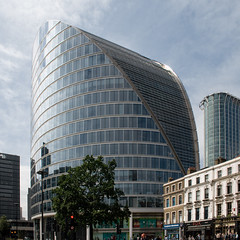
Moor House
London, United Kingdom
Foster + Partners
Canary Wharf Station
London, United Kingdom
Foster + Partners
Tower Bridge
London, United Kingdom
Horace Jones
UNITED KINGDOM / NEWCASTLE
Gateshead Millenium Bridge
Newscastle, England
Wilkinson Eyre Architecs
UNITED KINGDOM / PORTSMOUTH
Spinnaker Tower
Portsmouth, Hampshire, England
HGP Architects
HOME GEOGRAPHY ARCHITECTURE ENGINEERING SKYSCRAPERS
BRIDGES BUILDINGS TOWERS PUBLICATIONS ABOUT ME CONTACT
Copyright © José Miguel Hernández Hernández
Editor, Escritor y Fotógrafo de Arquitectura /
Publisher, Writer and Architectural Photographer
http://www.jmhdezhdez.com/ Leer más...
Etiquetas:
Architect,
architecture,
arquitectura,
Building,
London,
NEW CASTLE,
Norman foster,
Portsmouth,
Renzo Piano,
Richard Rogers,
TAMESIS
GREAT BRIDGES
Megyeri Bridge
Budapest, Hungary
Mátyás Hunyadi
Harilaos Trikoupis Bridge
Athens, Greece
B. Mikaelian, VINCI & Others
Viaduct Millau
Aveyron, France
Foster + Partners and
Michel Virlogeux
Juscelino Kubitschek Bridge
Brasilia, Brasil
Alexander Chan
Golden Gate Bridge
San Francisco, California, USA
Joseph B. Strauss y otros
Brooklyn Bridge
Manhattan, New York, USA
John Augustus Roebling
HOME GEOGRAPHY ARCHITECTURE ENGINEERING SKYSCRAPERS
BRIDGES BUILDINGS TOWERS PUBLICATIONS ABOUT ME CONTACT
Copyright © José Miguel Hernández Hernández
Editor, Escritor y Fotógrafo de Arquitectura /
Publisher, Writer and Architectural Photographer
http://www.jmhdezhdez.com/ Leer más...
ARCHITECTS / AMP ARQUITECTOS
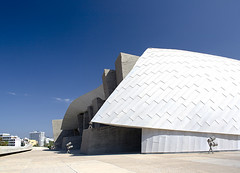
MAGMA Arte y Congresos
Adeje, Tenerife, Spain
HOME GEOGRAPHY ARCHITECTURE ENGINEERING SKYSCRAPERS
BRIDGES BUILDINGS TOWERS PUBLICATIONS ABOUT ME CONTACT
Copyright © José Miguel Hernández Hernández
Editor, Escritor y Fotógrafo de Arquitectura /
Publisher, Writer and Architectural Photographer
http://www.jmhdezhdez.com/ Leer más...
Etiquetas:
amp arquitectos,
arte,
artengo,
cabildo,
congresos,
convenciones,
costa adeje,
Fernando Menis,
líquido,
Magma,
olas marinas,
pastrana,
pilar,
roca chasnera,
roca-armario,
tenerife
MAGMA Arte & Congresos, Tenerife, Spain, 1998-2005
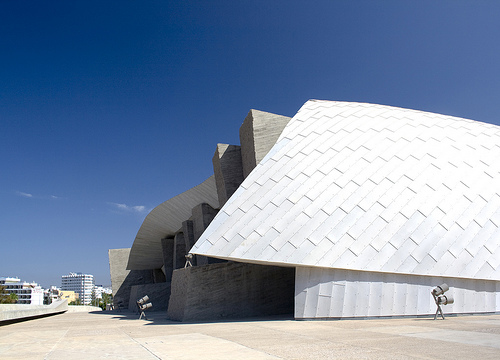
ESPAÑOL
Cliente: Canarias Congress Bureau Tenerife Sur
Arquitecto: AMP arquitectos
Felipe Artengo Rufino
Fernando Martín Menis
José Mª Rodríguez-Pastrana Malagón
Tipo: Centro de Convenciones
Superficie: 26.000 m²
La construcción del Edificio MAGMA Arte y Congresos surgió por la necesidad y la demanda de crear un nuevo recinto en el sur de la isla de Tenerife que pudiese ofrecer un servicio internacional de convenciones y eventos de diversa índole, carente hasta ese momento. MAGMA se imaginó por sus autores “como un líquido en movimiento” y se ha convertido en muy poco tiempo en un auténtico icono arquitectónico para la isla de Tenerife. El edificio sufrió diferentes cambios durante su larga fase de construcción, nada menos que casi una década, que fueron mejorando en gran medida sus condiciones obteniendo un resultado sorprendente y acorde con las necesidades tan ansiadas tanto por su Promotor, el Canarias Congress Bureau Tenerife Sur, así como por el equipo de AMP arquitectos, Artengo, Menis, Pastrana. La versatilidad del edificio puede acoger todo tipo de eventos tales como Conciertos, Congresos, Conferencias, Salas de Exposición, etc, haciendo de este importante espacio un verdadero edificio de futuro para la isla por ofrecer de este modo un uso enteramente polivalente y de vanguardia. MAGMA Arte y Congresos se encuentra localizado en la zona de Costa Adeje, y ofrece un fácil acceso ya que está integrado en la red de autopistas del sur de Tenerife. El edificio se erigió en una zona casi semidesértica rodeada de roca chasnera, un tipo de roca característica de este lugar; también muy cerca del mar y con la visión incondicional de la isla de la Gomera.
Tres son las entradas importantes que ofrece el espectacular edificio de diseño moderno e innovador. La entrada principal, que converge en el vestíbulo de gran tamaño, ofrece acceso a la cafetería y a las gradas del Auditorio; a su vez esta puede servir de evacuación en caso de posible incendio. Una entrada en el nivel superior da acceso a las oficinas, mientras que para los conciertos con una gran afluencia de público, se abre una entrada situada en el nivel inferior mediante una gran rampa peatonal con acceso desde la calle. El Auditorio, con capacidad para 3.000 personas y que se presenta como el espacio más importante del edificio debido fundamentalmente a sus dimensiones, tiene la particularidad de poder subdividirse a su vez en varias salas de menor tamaño para unas 300 personas cada una aproximadamente, mediante paneles con aislamiento acústico incorporado y que se cierran en las denominadas “rocas-armario”. Las paredes se inclinaron entre el 6 y el 14 %, no solo para conducir mejor el sonido hacia las zonas de audiencia, sino también para mejorar las condiciones acústicas evitando así que se produjese un posible eco.
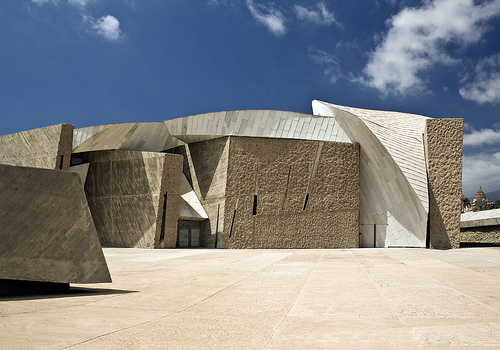
El edificio cuenta con una estructura principal metálica de vigas planas y otra secundaria telescópica de menores dimensiones y que unidas entre sí a diferentes niveles, dejan diferentes “grietas” por las que la luz natural penetra en su interior. La elección de los materiales que finalmente se emplearon lo ha condicionado en gran medida el entorno donde se ubicó el edificio, ya que se hizo el empleo del hormigón mezclado con el árido de piedra chasnera originaria del lugar en todos sus volúmenes. Para la enorme cubierta, que en opinión del propio equipo de arquitectos también simula "las olas marinas", se emplearon los paneles de fibra vegetal y de cemento a los que se les aplicó el tratamiento suficiente para encontrar cierta similitud con la propia roca originaria del lugar. El Edificio Magma Arte y Congresos, debido a su importancia para la isla de Tenerife y para toda Canarias, es comparable a otras obras emblemáticas diseñadas por arquitectos de reconocido prestigio internacional como el Auditorio de Tenerife o el nuevo Centro Cultural TEA Tenerife Espacio de las Artes, obras diseñadas por Santiago Calatrava y Herzog & de Meuron, respectivamente.
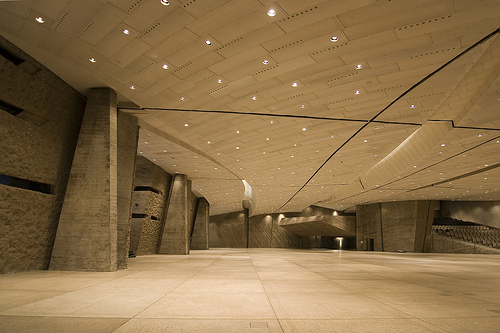
ENGLISH
Client: Canarias Congress Bureau Tenerife Sur
Architects: AMP arquitectos
Felipe Artengo Rufino
Fernando Martín Menis
José Mª Rodríguez-Pastrana Malagón
Type: Convention Center
Surface: 26,000 m²
The construction of the Building Arts and Congress MAGMA arose from the need and demand for a new campus in the south of the island of Tenerife that could offer an international service conventions and various events, lacking until now. MAGMA imagined by their authors "as a liquid in motion" and has very quickly become a true architectural icon for the island of Tenerife. The building underwent many changes during its long construction phase, nothing less than a decade, which were greatly improving their conditions getting a surprising result and consistent with needs as coveted as much for its promoter, the Canarias Congress Bureau Tenerife Sur and by the AMP architects, Artengo, Menis, Pastrana. The versatility of the building can accommodate all types of events such as Concerts, Meetings, Conferences, Exhibition Halls, etc., making this a truly important area of future building for the island to offer thus a multipurpose use and cutting edge entirely. MAGMA Art and Congress is located in the area of Costa Adeje, and is easily accessible as it is integrated in the motorway network in the south of Tenerife. It was erected in an area almost surrounded by rocky, semi-desert, a rock type characteristic of this place, also very close to the sea and the unconditional view of the island of La Gomera.
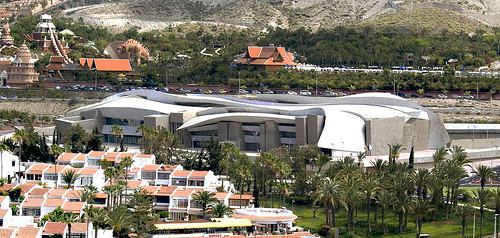
There are three important entries spectacular building offers modern and innovative design. The main entrance, which converges in the large foyer, with access to the cafeteria and the auditorium and in turn this can serve as a possible evacuation in case of fire. An entry in the upper level gives access to offices, while for the concerts with a large crowd, opening an entrance located on the lower level by a pedestrian access ramp from the street. The auditorium, with capacity for 3,000 people and is presented as the most important space of the building primarily due to its size, has the potential of moving further subdivided into several smaller rooms for 300 people each about using panels built soundproofed and that close in so-called "rocks" closet. " The walls were inclined between 6 and 14%, not just sound better to drive to areas of hearing, but also to improve the acoustics thereby avoiding possible to produce an echo.
The building has a metal main structure and a secondary flat beams smaller telescopic and joined together at different levels, leave different "cracking" through which natural light penetrates inside. The choice of materials used has finally largely conditioned environment where the building stood, as was the use of concrete mixed with stone aggregate chasnera originating in the place at all volumes. For the huge pool, which according to its own team of architects also simulates "ocean waves", we used panels of fiber and cement to which treatment was applied sufficient to find some similarity with the original rock itself place. The Magma Arts and Congress building, due to its importance for the island of Tenerife and the Canary Islands, is comparable to other iconic works designed by internationally renowned architects as the Auditorio de Tenerife or Tenerife TEA new Cultural Centre Arts Space works designed by Santiago Calatrava, Herzog & de Meuron, respectively.
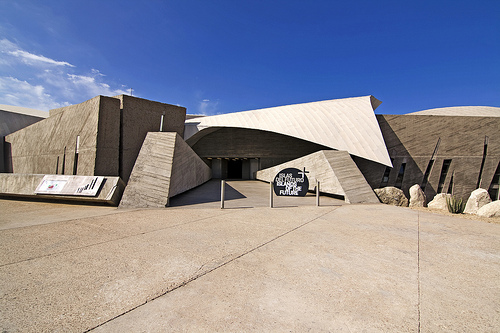
All the images of MAGMA Art & Congress here
"Images Magma Arte & Congresos"
Copyright © José Miguel Hernández Hernández
Visit the Web Official of MAGMA Art & Congress Centre: here
"Text" Copyright © José Miguel Hernández Hernández
Editor, Escritor y Fotógrafo de Arquitectura /
Publisher, Writer and Architectural Photographer
Todos los derechos reservados / All rights reserved
http://www.jmhdezhdez.com/
Other works in Canary Islands / Otras obras en Canarias
Auditorio de Tenerife
Santa Cruz de Tenerife,
Islas Canarias, Spain
Santiago Calatrava
Woermann Tower
Las Canteras, Gran Canaria,
Canary Island, Spain
Ábalos & Herreros
MUY IMPORTANTE!!! VERY IMPORTANT!!!
Deja tu comentario sobre este reportaje al pie de este post donde dice "Publicar un comentario en la entrada"; me será de gran valor para seguir mejorando este sitio web y te contestaré con la mayor brevedad posible... Muchas gracias!
No obstante, si te ha resultado interesante este reportaje y también el Blog en general, por favor, no dudes en hacerte Fan de la página de Fans del Blog de José Miguel Hernández Hernández en Facebook aquí
Nota importante: Una vez que hayas entrado en la página de Fans del Blog en Facebook, con sólo hacer click en el botón de "Me gusta", a partir de ese momento estarás al tanto de todos los nuevos reportajes interesantes relacionados con la Arquitectura y la Ingeniería que aquí se vayan publicando para no perder ningún detalle...
También puedes suscribirte por e-mail (te llegaría un e-mail con el enlace de cada artículo en el mismo momento en que sea publicado), o bien también puedes seguir el Blog a través de Twitter aquí
Nos vemos en el Blog!
Leave a comment on this story at the bottom of this post where it says "Post a comment in the entry", I will prove invaluable to further improve this website and I will answer as soon as possible .. . Thank you very much!
However, if you this story was interesting and the blog in general, please do not hesitate to make Fan Fans of the Blog page José Miguel Hernández Hernández on Facebook here
Very important: Once you enter the page Blog fan of Facebook, simply click on the button Like "From that moment you are aware of all new interesting stories related to the Architecture and Engineering are published here to avoid losing any detail ...
Can also subscribe by e-mail (I would e-mail with a link to each item in the same time it is published), or you can follow through Blog Twitter here
See you at the Blog!
HOME GEOGRAPHY ARCHITECTURE ENGINEERING SKYSCRAPERS
BRIDGES BUILDINGS TOWERS PUBLICATIONS ABOUT ME CONTACT
Copyright © José Miguel Hernández Hernández
Editor, Escritor y Fotógrafo de Arquitectura /
Publisher, Writer and Architectural Photographer
http://www.jmhdezhdez.com/ Leer más...
Etiquetas:
amp arquitectos,
arte,
artengo,
congresos,
Congress Bureau Sur,
convenciones,
costa adeje,
Fernando Menis,
líquido,
Magma,
olas marinas,
pastrana,
pilar,
roca chasnera,
roca-armario,
tenerife
Palacio de las Artes, Valencia, Spain, 1996-2005
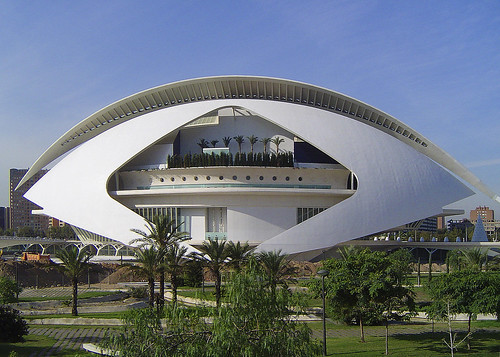
ESPAÑOL
Cliente: Autoridades Locales
Arquitecto: Santiago Calatrava
Uso: Ópera de Valencia
Superficie: 37.000 m²
El encargo del Palacio de las Artes Reina Sofía a Santiago Calatrava vino motivado por el cambio de Gobierno de la ciudad de Valencia, ya que en un principio se había previsto una Torre de Comunicaciones que se hubiese convertido en el elemento arquitectónico más alto y visible de la Ciudad de las Artes y las Ciencias de Valencia. Debido a este cambio, La Generalitat Valenciana prefirió más tarde encargarle al arquitecto un Auditorio. El enorme edificio, que teniendo en cuenta su curvatura en planta tiene unas medidas de 163 metros de longitud x 87 metros de ancho, es sin duda la obra más difícil realizada hasta el momento por Santiago Calatrava. El edificio está inspirado en la figura de una enorme ballena que sale a flote para respirar. Unas paredes laterales de hormigón revestidas de 20.000 m² de trencadís, contienen tras ellas varias escalinatas de acceso a las diferentes terrazas del edificio. El Palacio de las Artes Reina Sofía se erige espléndido en el lado más al norte de la Ciudad de las Artes y las Ciencias de Valencia, en el antiguo cauce del río Turia y muy próximo al Puente de Monteolivete, el cual adaptó Calatrava, ya que figuraba en el mapa incluso antes de proyectarse este enorme complejo cultural.
La majestuosa obra, de 70 metros de altura en su punto más alto, dispone de cuatro salas importantes; una Sala Principal, un Auditorio, el Aula magistral y un Teatro anexo. La Sala Principal tiene una capacidad para 1.700 espectadores y cuenta además con el segundo foso de coros más grande del mundo. La bella Sala, que se ubica en la parte media sur-este del edificio, se compone de un patio y cuatro niveles de palcos. El Auditorio, que tiene una capacidad para 1.500 espectadores, se sitúa en el nivel superior del lado sur. La cúpula de coronación, con forma de hoja de la naturaleza y que hace de cubierta para la sala situada en el nivel superior, recorre la totalidad del edificio de un lado al otro en una longitud de 230 metros. La estructura de sustento del edificio lo conforman nada menos que 77.000 m³ de hormigón y 30 toneladas de acero estructural, 20 corrugados. Sin lugar a dudas, esta obra construida para el proyecto tan importante de la Ciudad de Las Artes y las Ciencias, es la obra más compleja realizada por Santiago Calatrava. Tanto la anatomía humana como las formas orgánicas de la propia naturaleza, son la inspiración con la que el arquitecto sigue adelante en su búsqueda para con el arte abstracto.
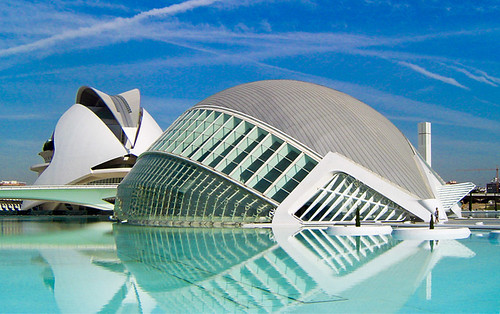
ENGLISH
Client: Local Authorities
Architect: Santiago Calatrava
Use: Opera Valencia
Area: 37,000 m²
The Palacio de las Artes Reina Sofía was motivated by the change of government in the city of Valencia, as initially planned a communications tower that would become the highest architectural element and visible from the City of Arts and Sciences in Valencia. Because of this change, the Generalitat Valenciana preferred later commissioned Santiago Calatrava Auditorium. The huge building, taking into account the curvature in plan has measures 163 meters long x 87 meters wide, is undoubtedly the most difficult work done so far by Santiago Calatrava. The building is inspired by the figure of a huge whale that comes out of breath. Side concrete walls covered with 20,000 m² trencadís contain several steps behind them access to different building terraces. El Palacio de las Artes Reina Sofía splendid stands on the side north of the City of Arts and Sciences in Valencia, in the old bed of the Turia River and close to Monteolivete Bridge, which Calatrava adapted as contained in the map projected even before this massive cultural complex.

The majestic piece, 70 feet high in its highest point, has four major rooms, a main hall, an auditorium, the classroom lecture and a theater annex. The Main Hall has capacity for 1,700 spectators and also has the second pit the world's largest choirs. The beautiful room, located on the south-eastern half of the building, consists of a courtyard and four levels of boxes. The auditorium, which has a capacity for 1,500 spectators, is located on the upper level on the south side. The crowning dome-shaped sheet of nature and makes room deck located on the upper level and run through the entire building from one side to another in a length of 230 meters. The support structure of the building is made up of no less than 77 000 m³ of concrete and 30 tons of structural steel, 20 corrugated. Undoubtedly, this work built for the important project of the City of Arts and Sciences, is the most complex undertaken by Santiago Calatrava. Both the human anatomy as the organic forms of nature are the inspiration with which the architect continues in his search for the abstract art.
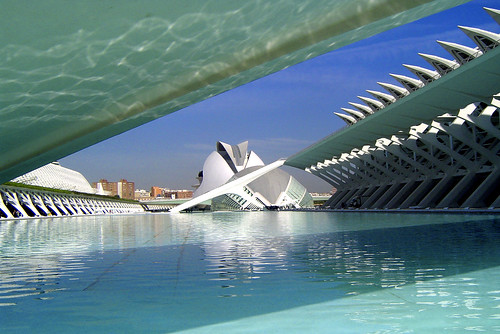
"Images Valencia Opera House"
Copyright © José Miguel Hernández Hernández
All the images of Valencia Opera House here: Set Flickr
"Text" Copyright © José Miguel Hernández Hernández
Editor, Escritor y Fotógrafo de Arquitectura /
Publisher, Writer and Architectural Photographer
Todos los derechos reservados / All rights reserved
http://www.jmhdezhdez.com/
References / Referencias
Santiago Calatrava-Turning Torso
Bellisco Ediciones, Madrid, 2008
by José Miguel Hernández Hernández
Español - English
+info
Related articles / Artículos relacionados
HSB Turning Torso
Malmo, Sweden
Puente del Alamillo
Sevilla, Andalucía, Spain
Aeropuerto de Sondica
Bilbao, Spain
Auditorio de Tenerife
Santa Cruz de Tenerife,
Islas Canarias, Spain
CAC Valencia
Ciudad de las Artes y
las Ciencias, Valencia, Spain
MUY IMPORTANTE!!! VERY IMPORTANT!!!
Deja tu comentario sobre este reportaje al pie de este post donde dice "Publicar un comentario en la entrada"; me será de gran valor para seguir mejorando este sitio web y te contestaré con la mayor brevedad posible... Muchas gracias!
No obstante, si te ha resultado interesante este reportaje y también el Blog en general, por favor, no dudes en hacerte Fan de la página de Fans del Blog de José Miguel Hernández Hernández en Facebook aquí
Nota importante: Una vez que hayas entrado en la página de Fans del Blog en Facebook, con sólo hacer click en el botón de "Me gusta", a partir de ese momento estarás al tanto de todos los nuevos reportajes interesantes relacionados con la Arquitectura y la Ingeniería que aquí se vayan publicando para no perder ningún detalle...
También puedes suscribirte por e-mail (te llegaría un e-mail con el enlace de cada artículo en el mismo momento en que sea publicado), o bien también puedes seguir el Blog a través de Twitter aquí
Nos vemos en el Blog!
Leave a comment on this story at the bottom of this post where it says "Post a comment in the entry", I will prove invaluable to further improve this website and I will answer as soon as possible .. . Thank you very much!
However, if you this story was interesting and the blog in general, please do not hesitate to make Fan Fans of the Blog page José Miguel Hernández Hernández on Facebook here
Very important: Once you enter the page Blog fan of Facebook, simply click on the button Like "From that moment you are aware of all new interesting stories related to the Architecture and Engineering are published here to avoid losing any detail ...
Can also subscribe by e-mail (I would e-mail with a link to each item in the same time it is published), or you can follow through Blog Twitter here
See you at the Blog!
HOME GEOGRAPHY ARCHITECTURE ENGINEERING SKYSCRAPERS
BRIDGES BUILDINGS TOWERS PUBLICATIONS ABOUT ME CONTACT
Copyright © José Miguel Hernández Hernández
Editor, Escritor y Fotógrafo de Arquitectura /
Publisher, Writer and Architectural Photographer
http://www.jmhdezhdez.com/ Leer más...
ARCHITECTS / ICTINO, CALÍCRATES, FIDIAS
Acropolis of Athens
Athens, Greece
HOME GEOGRAPHY ARCHITECTURE ENGINEERING SKYSCRAPERS
BRIDGES BUILDINGS TOWERS PUBLICATIONS ABOUT ME CONTACT
Copyright © José Miguel Hernández Hernández
Editor, Escritor y Fotógrafo de Arquitectura /
Publisher, Writer and Architectural Photographer
http://www.jmhdezhdez.com/ Leer más...
Etiquetas:
acropolis de atenas,
AKROPOLIS,
CALICRATES,
CARIATHIDS,
CARIATIDES,
COLUMNA,
DORICO,
fidias,
ICTINO,
JONICO,
MÁRMOL PENTÉLICO,
MONTE PENTÉLICO,
PARTHENON
Suscribirse a:
Comentarios (Atom)
